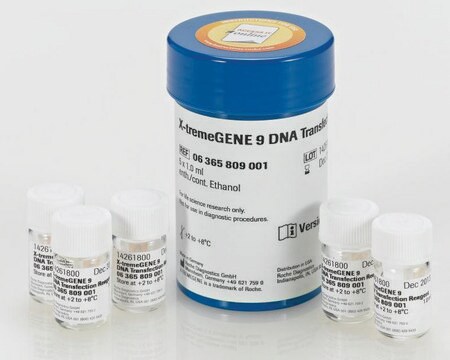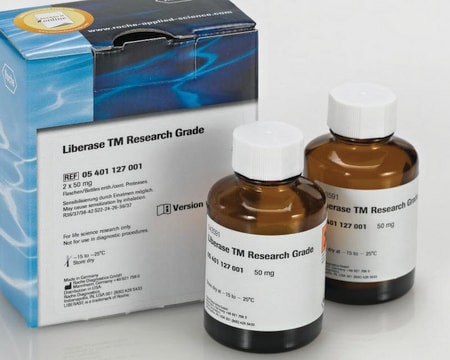CAPHOS
Calcium Phosphate Transfection Kit
Most cost effective transfection reagent kit for transient and stable transfection of DNA into mammalian cells
Synonyme(s) :
Gene delivery
About This Item
Produits recommandés
Qualité
for molecular biology
Niveau de qualité
Forme
solution
Utilisation
kit sufficient for 160 transfections (6 cm dishes)
kit sufficient for 400 transfections (3.5 cm dishes)
kit sufficient for 80 transfections (10 cm dishes)
Technique(s)
transfection: suitable
Conditions d'expédition
dry ice
Température de stockage
−20°C
Description générale
Application
- to enable transfection
- to transfect Hek293T cells
- to transfect H29D cells
BAEC
Bowels melanoma cells
CHO K1
COS-7
Fibroblasts (human embryonic, neo derm)
HEK293
Huh 7
IMR-90
LLC (Lewis Lung Carcinoma)
NIH3T3
PC-12
PCI-13
SH-Sy5Y
SK-Hep-1
T47D
Caractéristiques et avantages
- Suitable for transient and stable transfection
- Reproducible for a wide range of cell types
- Widely referenced
- Inexpensive
Composants
5 ml 2.5M CaCl2 (C2052)
25 ml 2x HEPES Buffered Saline (H1012)
25 ml molecular biology grade water (W4502)
Principe
Autres remarques
Produit(s) apparenté(s)
Mention d'avertissement
Warning
Mentions de danger
Conseils de prudence
Classification des risques
Eye Irrit. 2
Code de la classe de stockage
12 - Non Combustible Liquids
Point d'éclair (°F)
Not applicable
Point d'éclair (°C)
Not applicable
Certificats d'analyse (COA)
Recherchez un Certificats d'analyse (COA) en saisissant le numéro de lot du produit. Les numéros de lot figurent sur l'étiquette du produit après les mots "Lot" ou "Batch".
Déjà en possession de ce produit ?
Retrouvez la documentation relative aux produits que vous avez récemment achetés dans la Bibliothèque de documents.
Les clients ont également consulté
Articles
Transfection is the introduction of DNA, RNA, or proteins into eukaryotic cells and is used in research to study and modulate gene expression. Thus, transfection techniques and protocols serve as an analytical tool that facilitates the characterization of genetic functions, protein synthesis, cell growth and development.
This brief webinar provides an overview of what transfection is and the methods that are used to introduce DNA or RNA into eukaryotic cells.
Protocoles
Calcium Phosphate Transfection Kit Protocol
Notre équipe de scientifiques dispose d'une expérience dans tous les secteurs de la recherche, notamment en sciences de la vie, science des matériaux, synthèse chimique, chromatographie, analyse et dans de nombreux autres domaines..
Contacter notre Service technique













